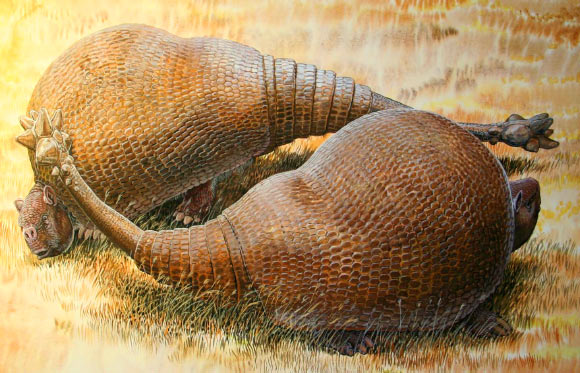An international group of scientists has successfully sequenced the whole mitochondrial genome of the ancient glyptodont – a heavily armored herbivorous mammal that went extinct in the Americas at the end of the last Ice Age.

This is an illustrated rendition of two male glyptodonts (Doedicurus clavicaudatus); massive, club-shaped tails were probably used more for intraspecific combat than defense against predators. Image credit: Peter Schouten.
Glyptodont looked like a gigantic and fearsome armadillo. Roughly the size and weight of a Volkswagen Beetle, the ancient animal was distinguished by its massive, heavy shell of armor, and a club-shaped, armored tail.
Although scientists like Charles Darwin collected partial remains of glyptodonts in the early 19th century, at first nobody knew what kind of mammal they represented.
It was eventually accepted that they must be related in some way to armadillos, the only other New World mammals to develop a protective bony shell.
However, because of the many physical differences between these two groups, most scientists have held the view that they must have separated very early in their evolutionary history.
“Glyptodonts in fact represent an extinct lineage that likely originated about 35 million years ago within the armadillo radiation,” explained team member Dr. Hendrik Poinar, a researcher with McMaster University, Canada, and senior author of a paper in the journal Current Biology.
“Glyptodonts should probably be considered a subfamily of gigantic armadillos,” added co-author Dr. Frédéric Delsuc, of CNRS.
“We speculate that the peculiar structure of their unarticulated carapace might have evolved as a response to the functional constraint imposed by the size increase they experienced over time.”
Using an innovative approach to recover genetic information from ancient specimens, the scientists successfully assembled the complete mitochondrial genome of Doedicurus — a gigantic glyptodont that lived until about 10,000 years ago — and compared it to that of all modern xenarthrans (anteaters, tree sloths and armadillos).
“Ancient DNA has the potential to solve a number of evolutionary questions, but it is often extremely difficult to obtain endogenous DNA, that is, DNA actually belonging to the animal being sampled, rather than some contaminant,” Dr Poinar said.
“In this particular case, we used a technical trick that allowed us to selectively enrich our Doedicurus DNA extract so that we had enough endogenous genetic material to work with,” the researchers explained.
Their phylogenetic analysis establishes that glyptodonts are in fact deeply nested within the armadillo crown group, representing a distinct subfamily (Glyptodontinae) within the family known as the Chlamyphoridae, represented today by the four-ounce pink fairy armadillo, or pichiciego (Chlamyphorus truncatus), and the giant armadillo (Priodontes maximus), which can weigh up to 80 kg, for instance.
Molecular dating suggests that glyptodonts diverged no earlier than about 35 million years ago.
Their findings also highlight the impressive increase in glyptodonts’ size over evolutionary time.
The scientists estimate that the last common ancestor of glyptodonts and their living armadillo relatives weighed in at a mere 6 kg, suggesting a spectacular increase in glyptodont body mass.
That’s consistent with the fossil record, which shows glyptodonts evolved from medium-sized forms (about 80 kg) to become true megafauna in the Pleistocene (reaching 2,000 kg) before their disappearance at the end of the last Ice Age.
The team intends to continue to explore ancient DNA lifted from numerous other fossil xenarthrans, including giant ground sloths.
_____
Frédéric Delsuc et al. 2016. The phylogenetic affinities of the extinct glyptodonts. Current Biology, vol. 26, no. 4, pp. R155-R156; doi: 10.1016/j.cub.2016.01.039







